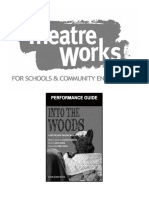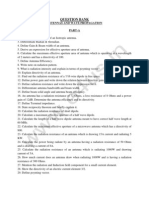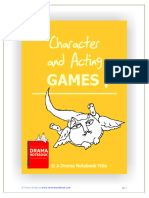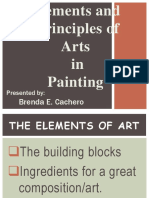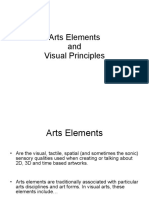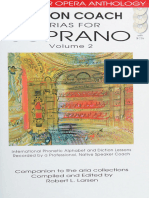Drama and Role-Play: Communication Games Without Words
Drama and Role-Play: Communication Games Without Words
Uploaded by
Ludwig Santos-Mindo De Varona-LptCopyright:
Available Formats
Drama and Role-Play: Communication Games Without Words
Drama and Role-Play: Communication Games Without Words
Uploaded by
Ludwig Santos-Mindo De Varona-LptOriginal Description:
Original Title
Copyright
Available Formats
Share this document
Did you find this document useful?
Is this content inappropriate?
Copyright:
Available Formats
Drama and Role-Play: Communication Games Without Words
Drama and Role-Play: Communication Games Without Words
Uploaded by
Ludwig Santos-Mindo De Varona-LptCopyright:
Available Formats
Drama and role-play
6
Children and young people gain social skills through acting out a story. As they take on different roles and
pretend to be, for example, an elderly person, or someone living with a disability, or someone being bullied,
they often gain new insights and sympathies. They can also practise and internalise life skills through role-
play. They may learn and practise new ways to communicate, how to be assertive with regard to their values
under peer pressure, different ways to manage conflict, and so on.
Communication games without words
! What am I telling you?
Divide players into small groups of even numbers, separated from each other. The groups each send a
member to the play leader who tells them something to communicate to their group without using
words. When the group guesses the message, a second member comes forward and asks for a new
message and they have to guess that. This continues until all members have had a turn. The first team
that finishes is the winner.
Simple messages for younger players might be: “I am hungry/angry/tired/afraid/happy/proud/surprised”;
or “I love you”, “leave me alone”, “come with me”, “stop”, “sit down”, “be quiet”. Older players can be
challenged to act out “jealousy”, “disgust”, “excitement”, “boredom”, “impatience”, and so on.
! Guess what I like?
All players stand in a circle. One by one they come forward and act out what they like most, without
speaking. Whoever guesses correctly takes the next turn – or nominates someone else if they have
already had a turn.
! Charades
Divide players into small groups to act out a word, without speaking. At first, and especially for younger
players, the word should have only two syllables. The group can choose a word themselves or the leader
can give them a list to choose from (try cupboard, laptop, bookcase, suitcase, playdough, schoolroom,
plateful, eyeball). They act the sound of the syllables (for example, rugby would be rug and bee) and the
rest of the players try to guess the word.
Part 2: Play activities 103
Role-play
Role-play can be introduced around many themes. These play activities are not aimed at a polished
performance, but rather the fun of putting it together.
! “Idols” and performances
A simple and popular theme is “Idols”, where participants take turns to sing or act. In groups they could
be challenged to make up little skits on “The scariest moment in my life!” or “The funniest …”. Older
children and young people may like to improvise a skit on a television programme or a fairy-tale.
! Role-play an issue of concern
Form groups of about five or six players and give them each a brief scenario to act out for the whole
group, taking only five minutes each. You can choose a relevant theme such “harassment and bullying”,
where group one acts out a scenario of a group of boys teasing a girl; group two are boys teasing a
young boy who is overweight and wears glasses; group three are girls excluding another girl from their
activities because she wears shabby clothes; group four are children ganging up against a refugee child;
group five are teasing a disabled child who walks with a limp.
After each role-play, discuss what happened and how the players felt – the powerful and the victims
each have a turn to talk. If there are any players who obviously enjoyed being bullies, repeat the role-play
and let them be the victims – but all in good fun! Let them discuss what the victims can do to protect
themselves. Discuss the role of good friends. The players may like to repeat the role-plays with a just and
fair outcome.
Let the players make up and chant slogans about being fair as they march and toyi-toyi round the room:
“Fair’s fair – don’t scare! We all belong to the human race!” or “It’s not cool to be cruel!” or “Stop
bullying!”, “Real men don’t hurt girls!”, and so on. If possible, let the players make posters.
! Puppets
Hold conversations, act out situations, make requests, all through the face of a puppet/ mask.
– Find pictures in magazines and newspapers of large faces and other items (such as food, cars,
homes, animals).
– Stiffen the picture by sticking it on scrap paper or thin card and then cut out the picture shape.
– Roll up a tube of paper and paste it on the back of the picture as a holding stick.
104 A Chance To Play
Drama themes for acting out
A dramatic theme or “story-line” can give focus to a play programme and be very appealing. Many games
can be adapted to fit in with the theme.
Some suggestions:
! The Circus – with clowns, performing animals, tumblers, balancing acts, balloons.
! The Game Reserve – with wild animals and birds, tour guides.
! The Olympics – with team banners and medals.
! Marine World – tag or catchers with fish and sharks (see page 85), penguin-race (feet hobbled),
octopus tangle (see page 31), rope games on board a ship (see page 41), and so on.
! Boot-sale drama
You will need an assortment of odd items (the funnier the better) such as an egg-whisk, umbrella, one
sandal, a potato, a ball, notebook, birthday-card, comb, cake of soap, can of beans, old key, tin mug,
paper plate, pencil, kitchen sieve, cap, sock, bath towel, old toy car.
Divide players into small groups and give each group five or six of the items you have collected. (Have
them ready in shopping bags to save time.) Each group has to invent a story that involves every item
they have been given, and they act it out for the whole group with every person taking a part.
Celebrating with art and culture
The Feast of the Clowns festival, organised by the Tshwane Leadership Foundation, is held every
August in Burgers Park, Tshwane. Dance, poetry, music, visual arts and play is celebrated and
promoted in a week-long programme that seeks to renew and celebrate the life of the inner-
city.
Many children contribute performances that
have involved long hours of practise and
dedication.
Children’s right to play includes a celebration
of arts and culture, and in this demonstra-
tion, the formalised and disciplined learning
of skills to express it.
For more information visit www.tlf.org.za.
Part 2: Play activities 105
Shadow plays
Shadow play actors (or mime artists) act out their skit by standing between a bright light in the background
and a sheet between themselves and the audience. Their movements are close to the sheet and the
audience sees their shadow through the sheet on the other side. Shadow dramas depend a lot on defined
and exaggerated movement, and the room should preferably be darkened.
Equipment needed for the shadow play stage:
! One or two white sheets.
! Rope across a room on which to peg or pin the sheets.
! At least two bright desk lamps (a spot light is even better).
! Long leads are needed to put lamps in the correct place.
! Miming
Use your body to mime different actions: talking and gestures; falling, walking with a limp, ranting and
raving; sobbing and sad; do things like tying a knot, getting dressed, graceful dancing, marching, and so
on. Provide music to stimulate movement. Experiment doing the actions face towards the sheet and side
on. Discuss together which works best. Experiment with placing the lights behind the actors.
Props can also be used to create shadows such as pieces of furniture or shapes cut out of card (a giant
insect, flower, tree, giant ice cream, and so on). Shapes can be stuck on sticks or backing so they stand
upright. If you use split pins, parts of the cardboard prop will be able to move; for example, a bird’s wing
moves up and down as if flying. Use wire attachments to make this happen.
! Drama and storytelling behind the sheet
Actors make use of the things they have learnt and prepare a skit to act out behind the sheet. The secret
is bright lights behind them and acting close up to the sheet to get a sharp image or shadow on the
other side.
! Finger and hand shadows
Start off by experimenting with finger and hand shadows so that everyone gets the idea. You could also
do hand shadows in a dark room with a strong torch.
Rabbit Dogs barking Snail creeping Birds flying
106 A Chance To Play
! A shadow play box theatre
Try all the shadow plays in a miniature format. Make a box theatre and encourage players to create their
own stories and characters, and to act these out. They could also act out traditional stories or fairy-
tales.
You could also make a puppet shadow theatre and work with the players to make their own puppets.
MAKING A PUPPET SHADOW THEATRE
Use a cardboard box and cut Cut out shapes of animals, The shadow puppet is held
a front window in it. Paste people, birds, household up with strong thin sticks or
or tape tracing paper or a objects and so on as props wire.
piece of stretched cloth over and characters.
the stage opening. Attach a separate wire to
You could make an arm or any moving parts (one stick
Shine a bright light behind leg move up and down by for holding up and another
the screen. attaching a moving part with for the moving part).
a split pin.
Part 2: Play activities 107
Dressing up
Imagination play 7
Shop at the next jumble sale and purchase garments that could transport children to another world: hats,
caps, shoes, jackets, large gowns, silky dresses, saris, waistcoasts, old jewellery, wellington boots, belts to
hold up too long dresses! Fabric scraps from a dressmaker’s shop or a fabric waste centre, that are tied or
pinned around small bodies can be made into any number of imaginative garments.
Granny kept her wedding dress and clothes from long ago and now
her granddaughters spend many happy hours playing dress-up with
them.
108 A Chance To Play
Play kits: Props for imaginative play
Children love to imitate and act out life as they see it. Encourage role-playing and story-making by providing
props to stimulate ideas and increase the fun.
RESTAURANT KIT: KITCHEN KIT: SCHOOL KIT:
Plastic or paper cups, saucers, Pots, pans, bowls, measuring Paper, pencils, old books,
plates, trays, cutlery, menus, cups, whisk, baking sheets, chalk board, crayons, story
tablecloth, tea pot, aprons. rolling pin, pastry cutters, books, tables and chairs.
Make play food: for example, frying pan, playdough, jelly,
cold tea or cool drink, papier- box made into a stove.
mâché fruit and vegetables.
SHOPPING KIT: CLEANING KIT: HOSPITAL OR CLINIC KIT:
Toy cash register, sales slips, Small brooms, dustpans, Adhesive tape, plasters,
play money, price tags, old dusters, cleaning liquid, cotton wool, stethoscope
ATM cards, shop supplies bucket, cloths. (real or plastic), small bottles
(empty product boxes, plastic filled with sweets (pretend
bottles, papier-mâché pills), pretend thermometer.
vegetables and eggs),
baskets, invent a trolley.
Ideas drawn from Learning Through Play written by Jean Marzollo and Janice Lloyd.
Part 2: Play activities 109
! Ideas for more play kits:
– Building: spade, bricks, mud, bricklaying
tools, spirit level, string, tool box (allow
children to use real tools if possible).
– Camping: tent, sticks for a pretend fire,
sleeping bag, cooking stuff, fishing rod, torch.
– Hair and beauty salon: brushes, creams, clips,
nail polish, ribbons, shampoo and water,
towels.
– Office: old computer, paper, pens, old phone,
briefcase, stamps, stapler, punch, old files,
stickers, in/out baskets.
– Fire rescue: fire helmets, red clothing, red
fabric for cloaks, gumboots, rope, hosepipe,
buckets, chairs for a fire truck.
“Strictly Come Dancing”
These children were mad about “Strictly Come
Dancing”, a ballroom dancing competition they
had watched on TV. For days they practised
their pieces and then held their own “Strictly
Come Dancing” show for parents in the
neighbourhood.
Children’s play can be inspired by music, being
able to observe the real thing in real life or
even on a TV programme.
These children had dressing up clothes, space
to practise and access to music to pursue
their dream of “ballroom” stardom!
110 A Chance To Play
You might also like
- MYP Unit Plan - Yr1 DramaDocument10 pagesMYP Unit Plan - Yr1 DramaLudwig Santos-Mindo De Varona-Lpt100% (5)
- A2.1-Listening Practice TestsDocument8 pagesA2.1-Listening Practice TestsTrương MyNo ratings yet
- O Sacred Heart O Love DivineDocument1 pageO Sacred Heart O Love DivineWin BerAngel100% (1)
- On Stage: Theater Games and Activities for KidsFrom EverandOn Stage: Theater Games and Activities for KidsRating: 4.5 out of 5 stars4.5/5 (8)
- Play Therapy Techniques Through The AgesDocument50 pagesPlay Therapy Techniques Through The Agesanon_19805214680% (10)
- Activities Based On SHREK The MUSICAL (Includes Lyrics)Document37 pagesActivities Based On SHREK The MUSICAL (Includes Lyrics)Facundo Yuffrida100% (1)
- MYP Unit Plan - Yr2 DramaDocument10 pagesMYP Unit Plan - Yr2 DramaLudwig Santos-Mindo De Varona-LptNo ratings yet
- Fairytales on Stage: A collection of children's plays based on famous fairy talesFrom EverandFairytales on Stage: A collection of children's plays based on famous fairy talesNo ratings yet
- Games and Activities For Your Family ReunionDocument5 pagesGames and Activities For Your Family Reunionellemig123No ratings yet
- Into The Woods Study Guide MiniDocument37 pagesInto The Woods Study Guide MiniTeatronc2013100% (2)
- 6th Sem Question BankDocument17 pages6th Sem Question BankJGPORGNo ratings yet
- Honegger - Danse de La Chevre For Solo FluteDocument2 pagesHonegger - Danse de La Chevre For Solo FlutePaul Cecchetti100% (9)
- Teaching With Dramatized ExperiencesDocument21 pagesTeaching With Dramatized ExperiencesShiela Marie VergaraNo ratings yet
- DN Character and Acting GameDocument28 pagesDN Character and Acting GameLisa McCormackNo ratings yet
- Brown and Beige Aesthetic Modern Group Project PresentationDocument16 pagesBrown and Beige Aesthetic Modern Group Project PresentationCASUL, ARAVELANo ratings yet
- Teaching With Contrive Experiences Teaching With Dramatized Experiences Aladin M. Awa - ReporterDocument6 pagesTeaching With Contrive Experiences Teaching With Dramatized Experiences Aladin M. Awa - ReporterGaoudam NatarajanNo ratings yet
- Making Make-Believe: Hands-on Projects for Play and PretendFrom EverandMaking Make-Believe: Hands-on Projects for Play and PretendRating: 5 out of 5 stars5/5 (2)
- Aralin 1 Finger Puppets by Sir Rei MarasiganDocument19 pagesAralin 1 Finger Puppets by Sir Rei MarasiganJasmin AsisNo ratings yet
- Eyeball Relay: Spider WebDocument7 pagesEyeball Relay: Spider WebLeow Zi Liang100% (1)
- Scout ActDocument5 pagesScout ActMagongcar hadjialiNo ratings yet
- D3 More Mini-PlaysDocument15 pagesD3 More Mini-Playscalvinsong.ozNo ratings yet
- Curriculum Connector: GruffaloDocument4 pagesCurriculum Connector: GruffalomontalvoartsNo ratings yet
- 12 Play Therapy 26122023 113049amDocument43 pages12 Play Therapy 26122023 113049amaz.rah.e.khudiNo ratings yet
- Story Telling and Process DramaDocument30 pagesStory Telling and Process Dramaanita rajeshNo ratings yet
- ARTS EXPRESS - Day Two Lesson PlanDocument2 pagesARTS EXPRESS - Day Two Lesson PlanOhHeyRayNo ratings yet
- This Drama GameDocument27 pagesThis Drama GameSuneeta singhNo ratings yet
- Teaching With ShadowDocument16 pagesTeaching With ShadowlogenNo ratings yet
- Resource Folder - Children 0-12 YearsDocument16 pagesResource Folder - Children 0-12 YearsbethhiNo ratings yet
- Dramatized ExperiencesDocument20 pagesDramatized ExperiencesEbon Baldoza OdosisNo ratings yet
- The Gruffalo Activity IdeasDocument1 pageThe Gruffalo Activity IdeasНаталія СмоліковаNo ratings yet
- Reptile Club PackDocument34 pagesReptile Club PackIqro NurulNo ratings yet
- Space Cats - The Universe's Cutest Roleplaying GameDocument76 pagesSpace Cats - The Universe's Cutest Roleplaying Gamefacing-0.android0% (1)
- Tips For Narrative MimeDocument3 pagesTips For Narrative MimeRyan ViewsNo ratings yet
- Ideas For ElementaryDocument9 pagesIdeas For ElementaryAmira RashadNo ratings yet
- Britlit Kit 1: Working With The Little Red Riding Hood FlashcardsDocument4 pagesBritlit Kit 1: Working With The Little Red Riding Hood FlashcardsFolahanmi AyoNo ratings yet
- Nate The Great Studyguide-1Document6 pagesNate The Great Studyguide-1stella99teacherNo ratings yet
- Word For Word Teacher's PackDocument40 pagesWord For Word Teacher's Packwizl100% (2)
- Games in The Young Learners'Document23 pagesGames in The Young Learners'Marisa ConstantinidesNo ratings yet
- Drama Games For StudentsDocument5 pagesDrama Games For StudentsJENELIN ENERONo ratings yet
- Play, Learn and Have Fun !Document27 pagesPlay, Learn and Have Fun !izo_katenaNo ratings yet
- GamesDocument11 pagesGamesMulholland Váradi EszterNo ratings yet
- Kidology Lecture NotesDocument10 pagesKidology Lecture Notesimpm1No ratings yet
- The 7 Stages of Grieving Education ResourcesDocument16 pagesThe 7 Stages of Grieving Education Resourcesq2krqj6qgmNo ratings yet
- PuppetryDocument8 pagesPuppetryErzsébet TamásNo ratings yet
- Organization of DramasDocument7 pagesOrganization of DramasZuhra HakimovaNo ratings yet
- Puppetry Activities For Preschool Children and FamiliesDocument7 pagesPuppetry Activities For Preschool Children and FamiliesMirjanaBoskovicNo ratings yet
- Tale WeaverDocument122 pagesTale WeaverAndy Havens100% (6)
- LittleLearnersLessonPack1 8752 PDFDocument204 pagesLittleLearnersLessonPack1 8752 PDFNOlivneto Dev100% (1)
- How Toteach Your First Drama ClassDocument15 pagesHow Toteach Your First Drama ClassAnonymous j8LfkG2100% (4)
- Drama Lesson PlansDocument6 pagesDrama Lesson PlansEdelin MoscosoNo ratings yet
- Play at Home with Elmo: Games and Activities from Sesame Street ®From EverandPlay at Home with Elmo: Games and Activities from Sesame Street ®No ratings yet
- Improvisation and PantomimeDocument7 pagesImprovisation and PantomimeAnonymous AtJitx3W100% (1)
- Arts 3 - 4th QuarterDocument18 pagesArts 3 - 4th Quartermauanayaby23No ratings yet
- What Shall We Do Now?: Five Hundred Games and PastimesFrom EverandWhat Shall We Do Now?: Five Hundred Games and PastimesNo ratings yet
- Halloween GamesDocument2 pagesHalloween GamesFolahanmi AyoNo ratings yet
- IcebreakersDocument1 pageIcebreakersJen RubleNo ratings yet
- Group 3 SSADocument21 pagesGroup 3 SSAJoylyn Lasola CorpuzNo ratings yet
- Monkey Puzzle Learning Activities July 2023Document5 pagesMonkey Puzzle Learning Activities July 2023Chanda AgarwalNo ratings yet
- Games To PlayDocument9 pagesGames To Playleslie12000No ratings yet
- DN Movement GamesDocument40 pagesDN Movement GamesLisa McCormackNo ratings yet
- Workshop 1Document30 pagesWorkshop 1Deepaktheater PareekNo ratings yet
- Fun GamesDocument7 pagesFun Gamesフェブリ クルニアントNo ratings yet
- Music Makes People HappyDocument2 pagesMusic Makes People HappyLudwig Santos-Mindo De Varona-LptNo ratings yet
- Different: Art ofDocument24 pagesDifferent: Art ofLudwig Santos-Mindo De Varona-LptNo ratings yet
- Anish MEN: A E FM CM D E Sus4 E ADocument2 pagesAnish MEN: A E FM CM D E Sus4 E ALudwig Santos-Mindo De Varona-LptNo ratings yet
- SpeechDocument12 pagesSpeechLudwig Santos-Mindo De Varona-LptNo ratings yet
- Dr. Carla PiperDocument7 pagesDr. Carla PiperLudwig Santos-Mindo De Varona-LptNo ratings yet
- Hum 150816103846 Lva1 App6891 PDFDocument172 pagesHum 150816103846 Lva1 App6891 PDFLudwig Santos-Mindo De Varona-Lpt100% (2)
- Cpar Elementsofart 180407210311Document22 pagesCpar Elementsofart 180407210311Ludwig Santos-Mindo De Varona-LptNo ratings yet
- Artslides Principleselements 161128172553Document71 pagesArtslides Principleselements 161128172553Ludwig Santos-Mindo De Varona-LptNo ratings yet
- Elementsofarts Painting 180605132721Document71 pagesElementsofarts Painting 180605132721Ludwig Santos-Mindo De Varona-LptNo ratings yet
- Arts Elements and Visual PrinciplesDocument50 pagesArts Elements and Visual PrinciplesLudwig Santos-Mindo De Varona-LptNo ratings yet
- San Lorenzo RuizDocument2 pagesSan Lorenzo RuizLudwig Santos-Mindo De Varona-LptNo ratings yet
- Art Grading Rubric Middle and HighschoolDocument1 pageArt Grading Rubric Middle and HighschoolLudwig Santos-Mindo De Varona-LptNo ratings yet
- Organization in The Visual Arts: Principles of DesignDocument58 pagesOrganization in The Visual Arts: Principles of DesignLudwig Santos-Mindo De Varona-LptNo ratings yet
- Irish Dela Cruz Saludares: Summary QualificationsDocument3 pagesIrish Dela Cruz Saludares: Summary QualificationsLudwig Santos-Mindo De Varona-LptNo ratings yet
- Songs For The Blessed Virgin MaryDocument3 pagesSongs For The Blessed Virgin MaryLudwig Santos-Mindo De Varona-Lpt100% (1)
- MYP Unit Plan - Yr3 DramaDocument10 pagesMYP Unit Plan - Yr3 DramaLudwig Santos-Mindo De Varona-Lpt100% (1)
- Hymns For The 4 Sunday of Easter BDocument2 pagesHymns For The 4 Sunday of Easter BLudwig Santos-Mindo De Varona-LptNo ratings yet
- For RoosterDocument10 pagesFor RoosterLudwig Santos-Mindo De Varona-Lpt100% (1)
- MYP Unit Plan - Grade 10Document10 pagesMYP Unit Plan - Grade 10Ludwig Santos-Mindo De Varona-LptNo ratings yet
- MYP Unit Plan - Grade 9Document10 pagesMYP Unit Plan - Grade 9Ludwig Santos-Mindo De Varona-LptNo ratings yet
- Bad RomanceDocument4 pagesBad Romancemrcristian_17892No ratings yet
- An Interview With Shakespeare (Answers)Document11 pagesAn Interview With Shakespeare (Answers)api-287526485No ratings yet
- Digital Modified Sine Wave Inverter CircuitDocument6 pagesDigital Modified Sine Wave Inverter CircuitMaster RajaNo ratings yet
- TV ChinaDocument1 pageTV ChinaingestevesNo ratings yet
- FCB Ev7500 TMDocument63 pagesFCB Ev7500 TMboisolivierNo ratings yet
- ADC SNR Performance by Kolsrud PDFDocument37 pagesADC SNR Performance by Kolsrud PDFTuyen DinhNo ratings yet
- Oprano : Diction CoachDocument70 pagesOprano : Diction CoachHana TawilNo ratings yet
- Scenes in The Square - WikipediaDocument4 pagesScenes in The Square - WikipediaT NgNo ratings yet
- Onebeat: Application DeadlinesDocument1 pageOnebeat: Application DeadlinesMaria RanimNo ratings yet
- UTC PC1353 Linear Integrated Circuit: TV Audio Processing CircuitDocument5 pagesUTC PC1353 Linear Integrated Circuit: TV Audio Processing CircuitrolandseNo ratings yet
- Past Simple Activity Part 1Document4 pagesPast Simple Activity Part 1Juan Felipe Torres MartinezNo ratings yet
- AP Loona TestDocument25 pagesAP Loona TestMajor AraujoVNo ratings yet
- Basic Principles of Ultrasonic Testing PDFDocument73 pagesBasic Principles of Ultrasonic Testing PDFSisira Chandrasoma100% (1)
- Hal Galper Article About Jazz CompingDocument11 pagesHal Galper Article About Jazz CompingTibso100% (2)
- Because - of - You Alto Sax-Alto - SaxophoneDocument2 pagesBecause - of - You Alto Sax-Alto - SaxophoneFernando CorreaNo ratings yet
- Musical Analysis and Journal Entry For Week 9: Analysis #1-Choose Any Piece From Your Week 9 Assigned MusicDocument7 pagesMusical Analysis and Journal Entry For Week 9: Analysis #1-Choose Any Piece From Your Week 9 Assigned Musicblon majorsNo ratings yet
- Exo-Pod: Passive Audio SplitterDocument12 pagesExo-Pod: Passive Audio SplitterSadak CharryNo ratings yet
- Summative Test 2 - Contemporary Arts (Quarter 3-Module 3 - 4)Document2 pagesSummative Test 2 - Contemporary Arts (Quarter 3-Module 3 - 4)Princess SaraNo ratings yet
- HAIL HOLY QUEEN From Sister ActDocument11 pagesHAIL HOLY QUEEN From Sister ActbiokojiroNo ratings yet
- Soal Paket Penilaian Tengah Semester Bahasa Inggris Kelas 7 8 9Document4 pagesSoal Paket Penilaian Tengah Semester Bahasa Inggris Kelas 7 8 9widiNo ratings yet
- 2075 High Power Transmitters System Manual-03Document37 pages2075 High Power Transmitters System Manual-03Dawit Leta100% (2)
- Bizet, Georges - Carmen GuitarDocument2 pagesBizet, Georges - Carmen GuitaragustinNo ratings yet
- DT 300Document17 pagesDT 300rojorojilloNo ratings yet
- Moving Into Deep Practice FinalDocument6 pagesMoving Into Deep Practice FinalVasileios TsiarasNo ratings yet
- Quentin TarantinoDocument2 pagesQuentin Tarantinochrisbarlow2No ratings yet
- Music Magazine Industry Research: Becky BaileyDocument13 pagesMusic Magazine Industry Research: Becky Baileyapi-26188535No ratings yet









